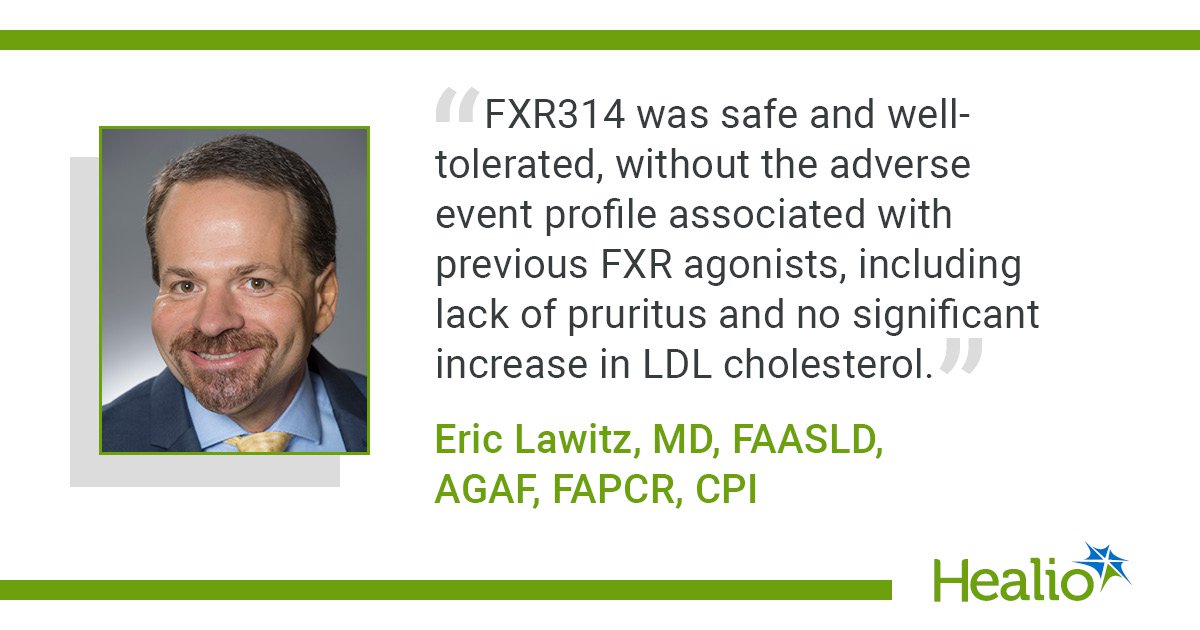November 18, 2024
2 min read

November 18, 2024
2 min read
SAN DIEGO — Once-daily FXR314 was well-tolerated and safely improved liver fat content and biochemical markers over 16 weeks in patients with metabolic dysfunction-associated steatohepatitis, according to research at The Liver Meeting.
“FXR314 is a novel, nonsteroidal non-bile acid [FXR (farnesoid X receptor)] agonist with a unique chemotype and functionality distinct from other FXR agonists,” Eric Lawitz, MD, FAASLD, AGAF, FAPCR, CPI, vice president of scientific and research development at The Texas Liver Institute and professor of medicine at University of Texas Health Science Center at San Antonio, told Healio.

Although FXR314 has shown clinical use in the treatment of patients with noncirrhotic MASH, limitations have prevented further development, Lawitz and colleagues wrote.
“Given the unique chemical scaffold, potency and differentiated intestinal-to-liver activation, we designed this trial to evaluate efficacy and determine if adverse event profile can be mitigated,” Lawitz said.
In a double-blind, phase 2 trial, 214 patients with MASH (37% type 2 diabetes; mean BMI, 36.6 kg/m2) were randomly assigned once-daily FXR314 (3 mg or 6 mg) or placebo for 16 weeks, followed by 4 weeks of follow-up. At baseline, the researchers reported a mean liver stiffness of 10.2 kPa and Controlled Attenuation Parameter of 351 dB/M.
Liver fat content was measured via MRI-Proton Density Fat Fraction at baseline and throughout the study.
Results showed patients treated with FXR314 3 mg and 6 mg achieved a 22.8% (P = .001) and 17.5% (P = .0267) least-squares mean percent of liver fat reduction, respectively, at the end of treatment compared with 6.1% among placebo-treated patients. In addition, at least a 30% reduction was reported in 29.2% (P = .0023) and 32.2% (P = .002) vs. 9.5%.
The researchers also observed reductions in alanine aminotransferase, with maximum declines from baseline of 11 U/L and 15.5 U/L vs. 8.1 U/L.
“FXR314 demonstrated statistically significant reduction in liver fat content and improvement in biochemical chemistries,” Lawitz said.
Further, the researchers reported that treatment-emergent adverse events were comparable across groups (68.1% vs. 73.2% vs. 67.6%) and mild to moderate in severity, with minimal drug-related treatment discontinuations. Specifically, there were no increases in pruritus (2.8% vs. 4.2% vs. 2.8%) or LDL cholesterol (1.5% vs. 4.5% vs. 3.6%), two notable FXR class adverse events.
“FXR314 was safe and well-tolerated, without the adverse event profile associated with previous FXR agonists, including lack of pruritus and no significant increase in LDL cholesterol,” Lawitz told Healio. “Additionally, the pharmacokinetic and pharmacodynamic evaluation in the MASH patients is supportive of a once-daily oral dosing.”
He continued, “MASH pathophysiology is complex, thus having multiple safe and effective mechanisms of action may aid in optimizing treatment approaches in patients with MASH. Here we presented safety and efficacy data that allows this FXR agonist, FXR314, to move into further clinical development … either alone or as part of a combination approach.”
Subscribe to get the latest posts to your email.